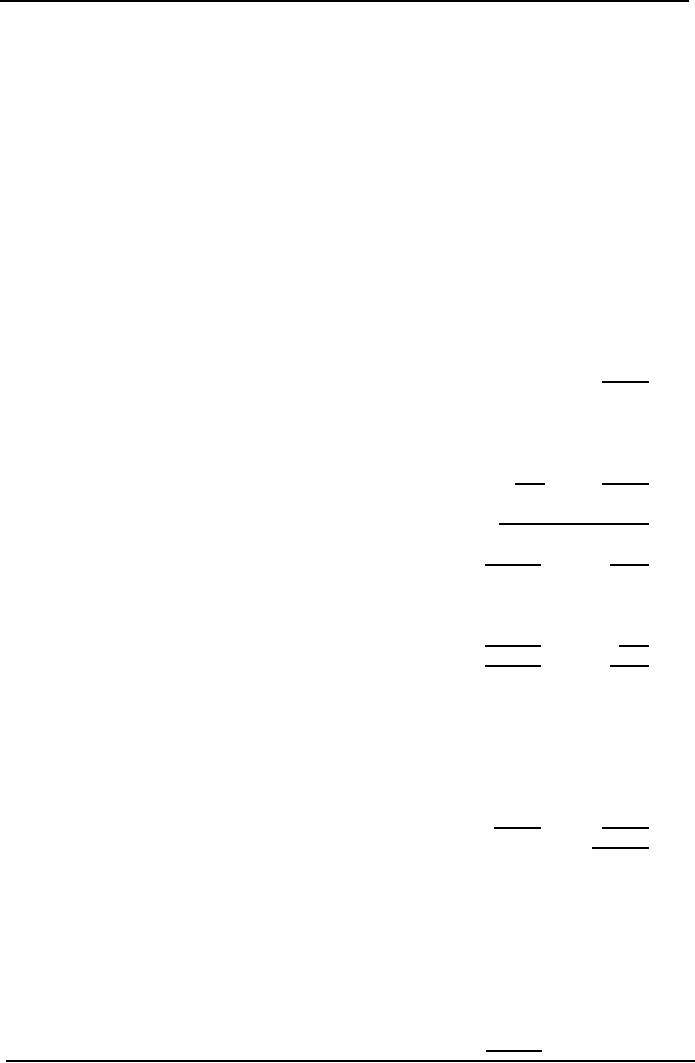 |
PROCESS COSTING SYSTEM:Normal Loss at the End of Process |
| << PROCESS COSTING SYSTEM:Cost of Production Report, Quantity Schedule |
| PROCESS COSTING SYSTEM:PRACTICE QUESTION >> |

Cost
& Management Accounting
(MGT-402)
VU
Normal
Loss at the End of
Process:
Preceding
discussion of normal loss is
for a situation where units
are lost at the beginning
or
during
manufacturing process in the department.
In many industries, lost units
are identified by
quality
inspectors at the end of
manufacturing process when
all production costs have
been
incurred
by the department. In such cases cost of
units lost is charged to completed
units only and
no
portion of loss is absorbed by
Units in work in process ending
inventory
For
this purpose lost units
are included in equivalent
production and the
adjustment for lost
units
is
not required, cost of lost
units is included in cost of
units completed and transferred
out or still
in
the department. This treatment
increases unit cost of completed
units only.
Assuming
that in department 2 lost
units are discovered in
final inspection at the end of
process,
cost
of production report of the
department will be as
follow:
Ginza
Beauty products
Department
2
Cost
of Production Report
For
the Month of January
2006
Quantity
Schedule.
Units
received from preceding
department
20,000
Units
transferred to next
department
16,000
Units
still in process
(80%
direct labor & factory
overhead)
3,500
Units
lost in process
Normal
loss (at the end of
process)
500
20,000
Total
Unit
Cost
Charged to Department.
Rupees
Rupees
Cost
from preceding
department
390,000
19.50
Cost
added by department:
Direct
labor
36,284
1.88
Factory
overhead
72,568
3.76
Total
cost added by
department
108,852
5.64
Total
cost to be accounted for
498,852
25.14
Cost
Accounted for as Follow
Rupees
Rupees
Transferred
to next department
(16,000
units x Rs. 25.93)
414,810
Work
in process ending inventory
Cost
from preceding
department
(3,500
units x Rs. 19.50)
68,250
Direct
labor (3,500 units x 80% x
Rs 1.88)
5,264
FOH
(3.500 units x 80% x Rs.
3.76)
10,528
84,042
Total
cost accounted for
498,852
Equivalent
units produced
16,000
+ (3,500 x 80%) + 500 = 19,300
units
Cost
per unit
Direct
labors
36,284/19,300
units
1.88
Factory
overhead
72,568/19,300
units
3.76
Cost
transferred to next department
16000
units x Rs. 25.14
402,240
Add
cost of lost units
500
units x Rs. 25.14
12,570
143
Table of Contents:
- COST CLASSIFICATION AND COST BEHAVIOR INTRODUCTION:COST CLASSIFICATION,
- IMPORTANT TERMINOLOGIES:Cost Center, Profit Centre, Differential Cost or Incremental cost
- FINANCIAL STATEMENTS:Inventory, Direct Material Consumed, Total Factory Cost
- FINANCIAL STATEMENTS:Adjustment in the Entire Production, Adjustment in the Income Statement
- PROBLEMS IN PREPARATION OF FINANCIAL STATEMENTS:Gross Profit Margin Rate, Net Profit Ratio
- MORE ABOUT PREPARATION OF FINANCIAL STATEMENTS:Conversion Cost
- MATERIAL:Inventory, Perpetual Inventory System, Weighted Average Method (W.Avg)
- CONTROL OVER MATERIAL:Order Level, Maximum Stock Level, Danger Level
- ECONOMIC ORDERING QUANTITY:EOQ Graph, PROBLEMS
- ACCOUNTING FOR LOSSES:Spoiled output, Accounting treatment, Inventory Turnover Ratio
- LABOR:Direct Labor Cost, Mechanical Methods, MAKING PAYMENTS TO EMPLOYEES
- PAYROLL AND INCENTIVES:Systems of Wages, Premium Plans
- PIECE RATE BASE PREMIUM PLANS:Suitability of Piece Rate System, GROUP BONUS SYSTEMS
- LABOR TURNOVER AND LABOR EFFICIENCY RATIOS & FACTORY OVERHEAD COST
- ALLOCATION AND APPORTIONMENT OF FOH COST
- FACTORY OVERHEAD COST:Marketing, Research and development
- FACTORY OVERHEAD COST:Spending Variance, Capacity/Volume Variance
- JOB ORDER COSTING SYSTEM:Direct Materials, Direct Labor, Factory Overhead
- PROCESS COSTING SYSTEM:Data Collection, Cost of Completed Output
- PROCESS COSTING SYSTEM:Cost of Production Report, Quantity Schedule
- PROCESS COSTING SYSTEM:Normal Loss at the End of Process
- PROCESS COSTING SYSTEM:PRACTICE QUESTION
- PROCESS COSTING SYSTEM:Partially-processed units, Equivalent units
- PROCESS COSTING SYSTEM:Weighted average method, Cost of Production Report
- COSTING/VALUATION OF JOINT AND BY PRODUCTS:Accounting for joint products
- COSTING/VALUATION OF JOINT AND BY PRODUCTS:Problems of common costs
- MARGINAL AND ABSORPTION COSTING:Contribution Margin, Marginal cost per unit
- MARGINAL AND ABSORPTION COSTING:Contribution and profit
- COST – VOLUME – PROFIT ANALYSIS:Contribution Margin Approach & CVP Analysis
- COST – VOLUME – PROFIT ANALYSIS:Target Contribution Margin
- BREAK EVEN ANALYSIS – MARGIN OF SAFETY:Margin of Safety (MOS), Using Budget profit
- BREAKEVEN ANALYSIS – CHARTS AND GRAPHS:Usefulness of charts
- WHAT IS A BUDGET?:Budgetary control, Making a Forecast, Preparing budgets
- Production & Sales Budget:Rolling budget, Sales budget
- Production & Sales Budget:Illustration 1, Production budget
- FLEXIBLE BUDGET:Capacity and volume, Theoretical Capacity
- FLEXIBLE BUDGET:ANALYSIS OF COST BEHAVIOR, Fixed Expenses
- TYPES OF BUDGET:Format of Cash Budget,
- Complex Cash Budget & Flexible Budget:Comparing actual with original budget
- FLEXIBLE & ZERO BASE BUDGETING:Efficiency Ratio, Performance budgeting
- DECISION MAKING IN MANAGEMENT ACCOUNTING:Spare capacity costs, Sunk cost
- DECISION MAKING:Size of fund, Income statement
- DECISION MAKING:Avoidable Costs, Non-Relevant Variable Costs, Absorbed Overhead
- DECISION MAKING CHOICE OF PRODUCT (PRODUCT MIX) DECISIONS
- DECISION MAKING CHOICE OF PRODUCT (PRODUCT MIX) DECISIONS:MAKE OR BUY DECISIONS